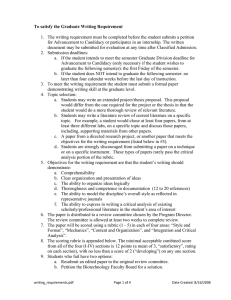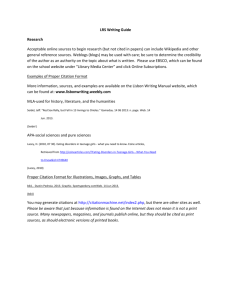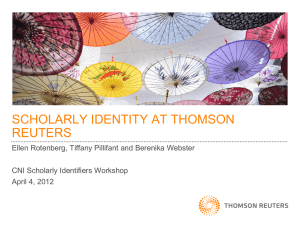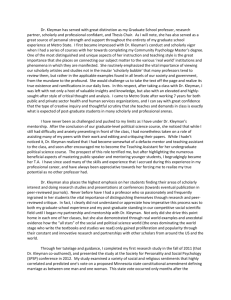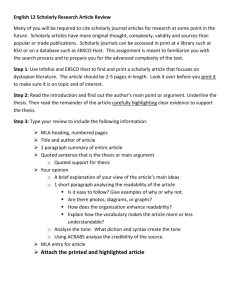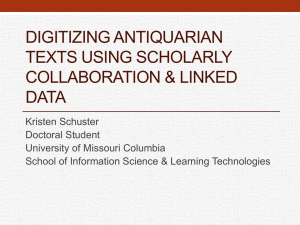Rubric for Flagship Paper
advertisement
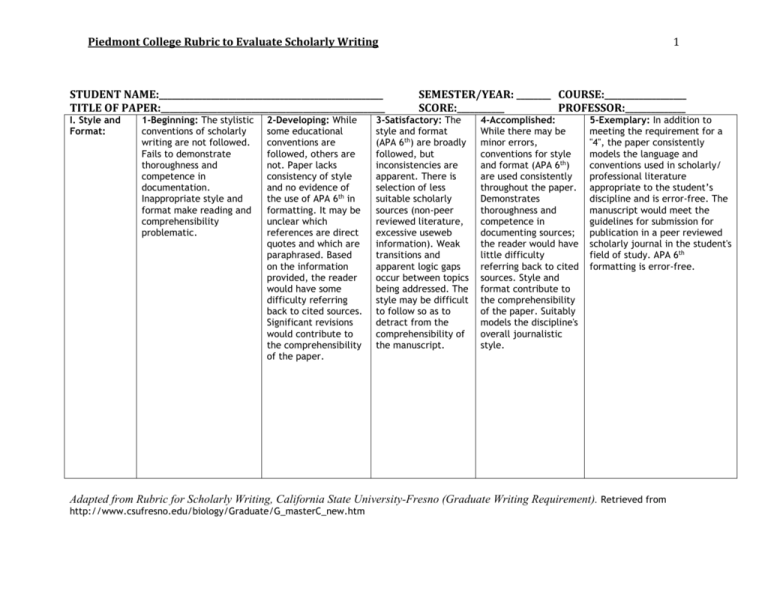
Piedmont College Rubric to Evaluate Scholarly Writing STUDENT NAME:____________________________________________________ TITLE OF PAPER:____________________________________________________ I. Style and Format: 1-Beginning: The stylistic conventions of scholarly writing are not followed. Fails to demonstrate thoroughness and competence in documentation. Inappropriate style and format make reading and comprehensibility problematic. 2-Developing: While some educational conventions are followed, others are not. Paper lacks consistency of style and no evidence of the use of APA 6th in formatting. It may be unclear which references are direct quotes and which are paraphrased. Based on the information provided, the reader would have some difficulty referring back to cited sources. Significant revisions would contribute to the comprehensibility of the paper. 1 SEMESTER/YEAR: ________ COURSE:___________________ SCORE:___________ PROFESSOR:______________ 3-Satisfactory: The style and format (APA 6th) are broadly followed, but inconsistencies are apparent. There is selection of less suitable scholarly sources (non-peer reviewed literature, excessive useweb information). Weak transitions and apparent logic gaps occur between topics being addressed. The style may be difficult to follow so as to detract from the comprehensibility of the manuscript. 4-Accomplished: While there may be minor errors, conventions for style and format (APA 6th) are used consistently throughout the paper. Demonstrates thoroughness and competence in documenting sources; the reader would have little difficulty referring back to cited sources. Style and format contribute to the comprehensibility of the paper. Suitably models the discipline's overall journalistic style. 5-Exemplary: In addition to meeting the requirement for a "4", the paper consistently models the language and conventions used in scholarly/ professional literature appropriate to the student’s discipline and is error-free. The manuscript would meet the guidelines for submission for publication in a peer reviewed scholarly journal in the student's field of study. APA 6th formatting is error-free. Adapted from Rubric for Scholarly Writing, California State University-Fresno (Graduate Writing Requirement). Retrieved from http://www.csufresno.edu/biology/Graduate/G_masterC_new.htm Piedmont College Rubric to Evaluate Scholarly Writing II. Mechanics: 1-Beginning: Paper contains numerous errors in spelling, grammar, and/or sentence structure, which make following the logic of the paper extremely difficult. Educational terms are misused. 2-Developing: Frequent errors in spelling, grammar (such as subject/verb agreements and tense), sentence structure and/or other writing conventions make reading difficult and interfere with comprehensibility. There is some confusion in the proper use of educational terms. Writing does not flow smoothly from point to point; appropriate transitions are lacking. 3-Satisfactory: Grammatical conventions are generally used, but inconsistency and/or errors in their use result in weak, but still apparent, connections between topics in the formulation of the argument. There is poor or improper use of headings and related features to keep the reader on track within the topic. Effective academic vocabulary is used. 2 4-Accomplished: While there may be minor errors, the paper follows normal conventions of spelling and grammar throughout. Errors do not significantly interfere with topic comprehensibility. Transitions and organizational structures such as subheadings are effectively used which help the reader move from one point to another. 5-Exemplary: In addition to meeting the requirements for a "4", the paper is error free in terms of mechanics. Writing flows smoothly from one idea to another. Transitions effectively establish a sound scholarly argument and aid the reader in following the writer's logic. Adapted from Rubric for Scholarly Writing, California State University-Fresno (Graduate Writing Requirement). Retrieved from http://www.csufresno.edu/biology/Graduate/G_masterC_new.htm Piedmont College Rubric to Evaluate Scholarly Writing III. Content and Organization: 1-Beginning: Analysis of existing scholarly / professional literature on the topic is inadequate. Content is poorly focused and lacks organization. The reader is left with little information about or little understanding of the paper's topic. 2-Developing: The paper is logically and thematically coherent, but is lacking in substantial ways. The content may be poorly focused or the scholarly argument weak or poorly conceived. Major ideas related to the content may be ignored or inadequately explored. Overall, the content and organization needs significant revision to represent a critical analysis of the topic. 3-Satisfactory: Ideas presented closely follow conventional concepts with little expansion and development of new directions. Certain logical connections or inclusion of specific topics related to the student’s area of study may be omitted. Ideas and concepts are generally satisfactorily presented although lapses in logic and organization are apparent. The reader is suitably introduced to the topic being presented such that the relationship to the student’s area of study is obvious. 3 4-Accomplished: Follows all requirements for the paper. Topic is carefully focused. Clearly outlines the major points related to the topic; ideas are logically arranged to present a sound scholarly argument. Paper is interesting and holds the reader's attention. Does a credible job summarizing related literature. General ideas are expanded upon in a logical manner thereby extending the significance of the work presented beyond a restatement of known ideas. 5-Exemplary: In addition to meeting the requirements for a "4", excels in the organization and representation of ideas related to the topic. Raises important issues or ideas, which may not have been represented in the literature cited. Would serve as a basis for further research on the topic. Adapted from Rubric for Scholarly Writing, California State University-Fresno (Graduate Writing Requirement). Retrieved from http://www.csufresno.edu/biology/Graduate/G_masterC_new.htm Piedmont College Rubric to Evaluate Scholarly Writing IV. Integration and Critical Analysis: 1-Beginning: The manuscript contains numerous flaws in the essential components of a literature review. The manuscript lacks a successful synthesis of disparate works, and there is no logical flow to the presentation. These issues result in a manuscript with limited comprehensibility and utility in illustrating the author’s effective grasp of the material. 2-Developing: Weakness is evident in the coverage of the field and analysis resulting in incorrect or poorly developed synthesis of results. Analysis is limited to categorizing and summarizing scholarly topics. The resulting manuscript significantly degrades the comprehensibility of the document and the identification of knowledge gaps 3-Satisfactory: Identification of key topics or uncertainties in the field may be incomplete. New concepts resulting from a synthetic presentation of ideas is poorly developed or lacking. Complex topics and related concepts are awkwardly presented and linkages among topics may be unclear. 4 4-Accomplished: There are inconsistencies in the organization and logic of the presentation, but still clear analysis of the presented materials. While synthesis of all aspects of the topic may show varying degrees of development, the overall consistency, thoroughness, and analysis result in a well-crafted document. 5-Exemplary: The document presents the current state of knowledge for the topic being addressed utilizing a diversity of scholarly opinions. These various, and possibly conflicting, opinions are presented in a balanced manner and seamlessly woven together to illustrate a complete grasp of the scholarly literature across multiple research approaches utilizing appropriate national and international peer-reviewed journals. Essential findings of multiple sources are accurately and concisely paraphrased, analyzed, and integrated. Original sources are clearly identified and correctly cited in both the body of the text and the reference section. Organizationally, smooth and effective transitions between topics lead the reader through an orderly discussion of the topic being addressed. The gaps in current knowledge are clearly identified and significant directions and approaches that fill these gaps are identified. Adapted from Rubric for Scholarly Writing, California State University-Fresno (Graduate Writing Requirement). Retrieved from http://www.csufresno.edu/biology/Graduate/G_masterC_new.htm
